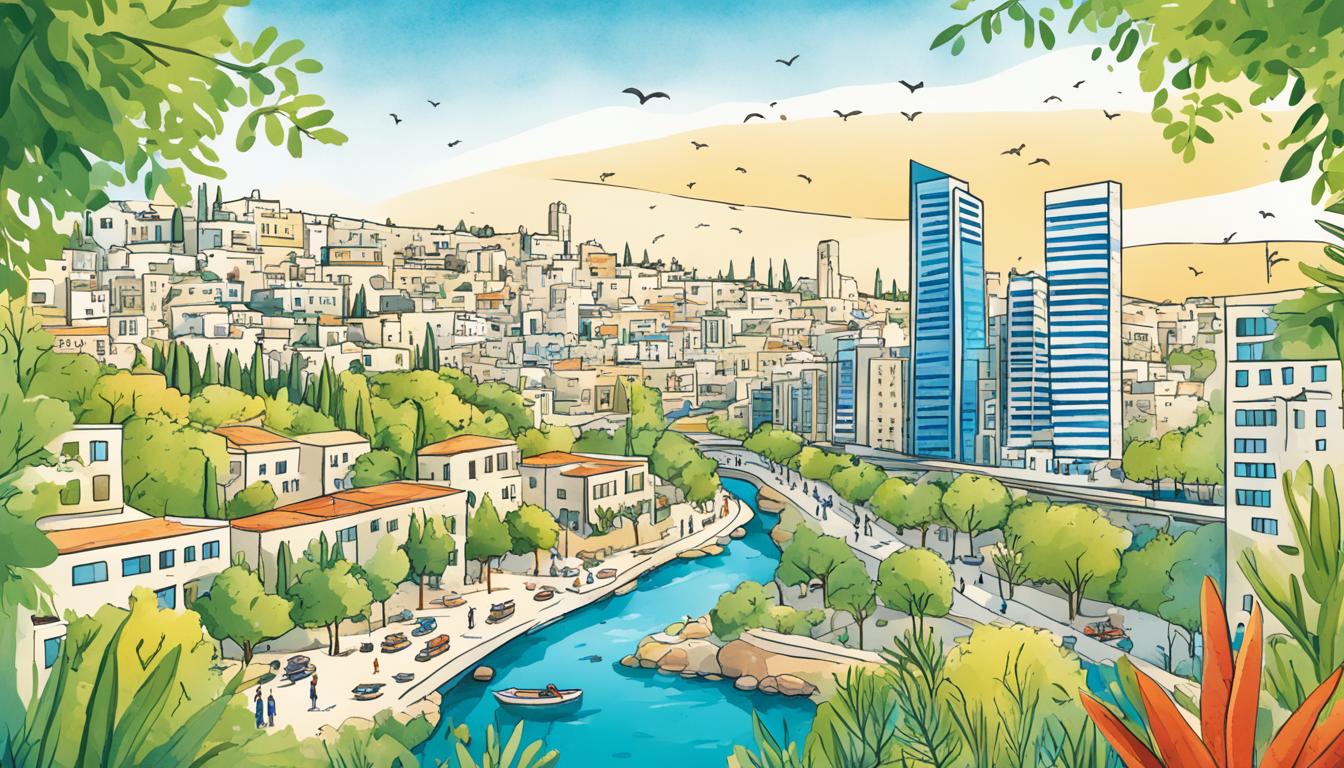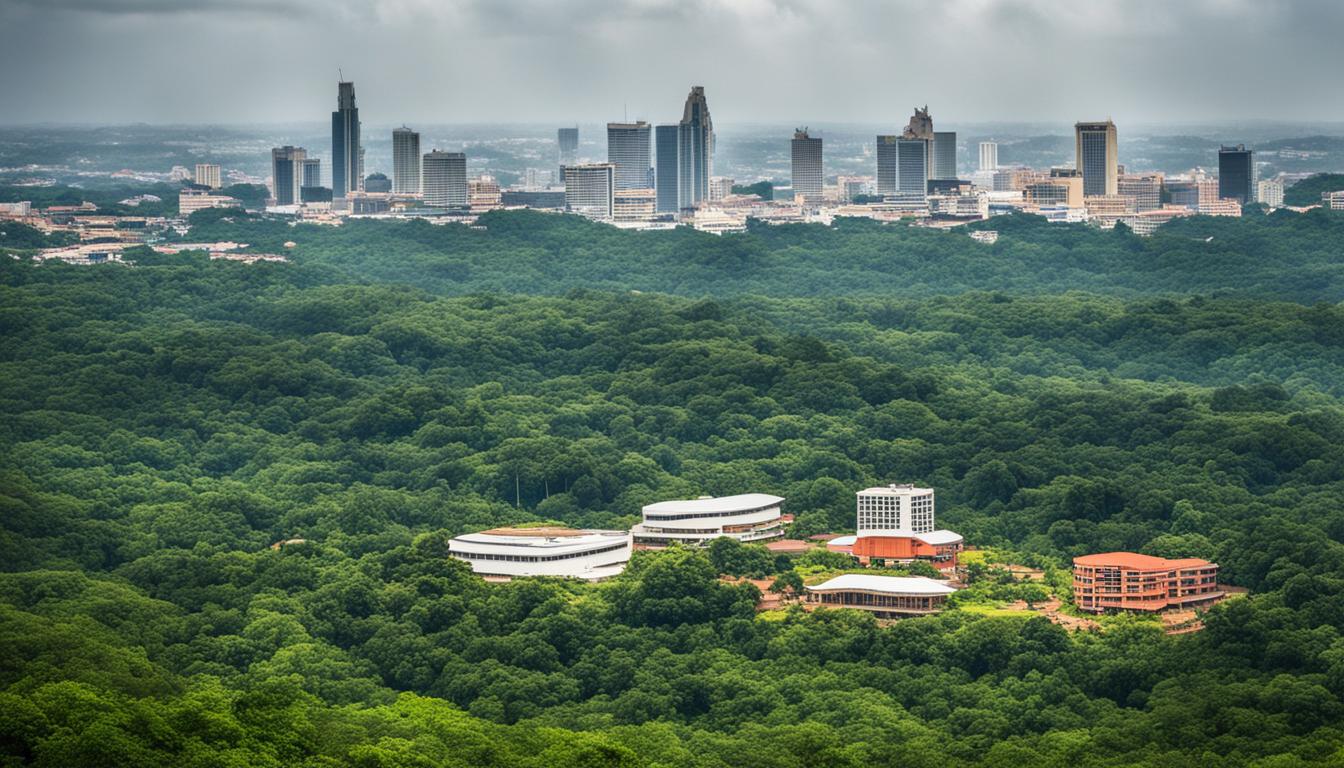Monaco Biodiversity: Animal and Plant Species and What Is Under Threat
Welcome to our article on Monaco’s biodiversity and the conservation efforts in place to protect its unique wildlife and plant species. Monaco may be small in size, but it is committed to preserving its natural heritage and promoting nature preservation. Let’s explore the fascinating world of Monaco’s biodiversity and the challenges it faces in maintaining its delicate ecosystem.
Key Takeaways
- Monaco aims to achieve the 2020 Aichi Biodiversity Targets through sustainable development practices and initiatives.
- The country has established protected areas and marine reserves to preserve its marine biodiversity.
- Monaco actively supports biodiversity conservation through partnerships and initiatives.
- While Monaco may have limited forests and protected areas, efforts are being made to protect and conserve its wildlife and plant species.
- The country’s commitment to sustainable development is evident through its support for environmental protection and renewable energy.
Forest Cover
Monaco, due to its small size and urban development, has no significant forest cover. The country’s land is primarily urban, and there are no primary forests within its borders. Between 1990 and 2000, no changes in forest cover were reported. This lack of forested areas has a direct impact on the biodiversity of Monaco, as forests provide vital habitats for a diverse range of species.
Note: The image above showcases the prominent urban landscape of Monaco, highlighting the absence of significant forest cover.
Protected Areas
Monaco has limited protected areas, with two marine protected areas covering a total of 35.5 hectares. These areas are crucial for the conservation of marine biodiversity in Monaco’s territorial waters. Additionally, Monaco is part of the PELAGOS Sanctuary for Mediterranean Marine Mammals, designated as a Specially Protected Area of Mediterranean Importance (SPAMI) by the Barcelona Convention. While Monaco’s protected areas are relatively small, they play a vital role in preserving the country’s marine biodiversity.

Biodiversity – Wildlife
Monaco is home to a variety of wildlife species, including amphibians, birds, mammals, and reptiles. Although Monaco’s wildlife diversity may not rival that of other countries, efforts are underway to protect and conserve these species.
Currently, Monaco has one species of amphibian, 12 species of birds, four species of mammals, and five species of reptiles. While none of these species are endemic or threatened, their preservation is still important for maintaining the country’s biodiversity.
Protecting wildlife is crucial for maintaining the ecological balance and ensuring the long-term survival of various species. By implementing conservation measures, Monaco contributes to the overall preservation of global biodiversity.
“Conservation is a vital part of our responsibility to protect the natural heritage of Monaco and promote a sustainable future.”
Wildlife Species in Monaco:
| Category | Number of Species |
|---|---|
| Amphibians | 1 |
| Birds | 12 |
| Mammals | 4 |
| Reptiles | 5 |

Biodiversity – Plants
In Monaco, the diversity of plant species is limited due to its small size and lack of forested areas. There are no known endemic plant species in the country, which means that plant species found in Monaco can also be found in other regions. Despite this, Monaco does not have any tree species listed on the IUCN Red List as critically endangered, endangered, or vulnerable.
However, it is important to consider the impact of limited forest cover on the abundance and diversity of plant species in Monaco. The lack of natural habitats restricts the number of plant species that can thrive in the country. Trees and forests provide essential habitats for various plant species, and without significant forested areas, the diversity and abundance of plant life in Monaco are limited.

Environment
Monaco is committed to the protection of its environment and actively participates in international agreements concerning climate change, biodiversity conservation, and marine pollution. The country recognizes the importance of safeguarding its natural heritage and strives to maintain a safe and sustainable living environment.
Unlike many other regions, Monaco has the advantage of not facing significant natural hazards, making it a relatively secure place to reside. The absence of major environmental risks allows residents and visitors to enjoy the beauty of Monaco without the constant worry of natural disasters.
That being said, Monaco’s urbanized landscape presents unique challenges in maintaining a balance between development and preserving the natural environment. With limited land area available, there is a constant need to consider sustainable practices and ensure that urban expansion does not come at the expense of the country’s natural resources.

The Need for Environmental Protection
As an urbanized area, Monaco’s development requires careful planning and management to minimize environmental impacts. The government, along with various organizations and stakeholders, is dedicated to implementing measures that protect and conserve Monaco’s natural surroundings.
Efforts are underway to promote environmental awareness among residents and tourists. Initiatives such as waste segregation, recycling programs, and the promotion of renewable energy sources are aiming to reduce Monaco’s ecological footprint and preserve its natural resources for future generations.
“The preservation of Monaco’s natural environment is crucial for maintaining the unique beauty of the region and ensuring a sustainable future for its residents.”
Environmental protection is a collective responsibility, and Monaco understands the significance of global cooperation in addressing environmental challenges. The country actively engages in international dialogues and partnerships to share knowledge, exchange best practices, and contribute to global efforts towards a greener and more sustainable planet.
Land Use and Resources
Monaco, as a predominantly urbanized region, faces unique challenges in terms of land use and natural resources. With no arable land or significant agricultural activities, the country heavily relies on services, tourism, and small-scale industries for its economy.
Due to its limited land resources, Monaco emphasizes careful land use planning to strike a balance between development and environmental conservation. The preservation of green spaces, urban parks, and sustainable urban design are key considerations in Monaco’s development strategies.
While Monaco does not possess significant natural resources, it compensates through its thriving tourism industry, attracting visitors from all over the world who are captivated by its luxurious amenities and breathtaking views of the Mediterranean coastline.
The following table provides a breakdown of Monaco’s economic sectors:
| Sector | Contribution to Economy |
|---|---|
| Tourism | Primary driver of the economy, generating significant revenue through hotels, restaurants, and attractions. |
| Services | Includes finance, banking, consulting, and other professional services, contributing to the country’s prosperity. |
| Small-Scale Industries | Manufacturing and production of luxury goods, perfumes, and other specialty items contribute to the local economy. |
Monaco’s commitment to sustainable development ensures that environmental conservation remains a top priority, even in the face of urbanization and limited resources.

Economy
Monaco’s economy revolves around its thriving tourism industry, attracting visitors from around the world who are drawn to its renowned casino scene and pleasant climate. With its tax haven status, Monaco also appeals to individuals and companies seeking favorable tax conditions. However, the economy of Monaco goes beyond tourism and tax benefits. The principality has successfully diversified its economic activities, focusing on services and small, non-polluting industries to ensure sustainable development.
The commitment to sustainable development is evident in Monaco’s support for environmental protection, biodiversity conservation, and renewable energy initiatives. The principality recognizes the importance of preserving its natural resources and aims to strike a balance between economic growth and environmental preservation.
In addition to tourism, Monaco’s economy thrives on several other sectors, such as finance, real estate, and international trade. These sectors contribute to the overall economic stability and prosperity of the principality.
Monaco’s commitment to sustainable development is evident through its support for environmental protection, biodiversity conservation, and renewable energy.
Tourism
Tourism plays a pivotal role in Monaco’s economy, with the principality offering a unique blend of luxury, entertainment, and natural beauty. Visitors are drawn to the iconic Monte Carlo Casino, the picturesque Prince’s Palace, and the scenic coastline. The numerous high-end hotels, restaurants, and shopping destinations further enhance the appeal of Monaco as a tourist destination.
The principality also hosts world-class events, including the Formula One Grand Prix and the Monaco Yacht Show, attracting a wealthy and glamorous clientele. These events contribute significantly to the local economy, generating substantial revenue and creating employment opportunities.
Tax Haven
Monaco’s status as a tax haven has long attracted individuals and businesses looking to optimize their tax strategies. The principality offers favorable tax conditions, including low personal and corporate taxes, making it an attractive destination for high-net-worth individuals and companies.
However, Monaco has taken steps to ensure that its tax system complies with international standards and regulations. The principality has signed tax information exchange agreements and actively participates in global efforts to combat tax evasion and money laundering.
Diversification and Sustainability
In recent years, Monaco has focused on diversifying its economy to reduce its reliance on any single sector. The principality has encouraged the growth of service-based industries such as banking, financial services, and real estate. Moreover, Monaco has fostered the development of small-scale industries that prioritize sustainability and minimize environmental impact.
Monaco’s commitment to sustainable development extends beyond its economic diversification efforts. The principality actively promotes environmental protection and biodiversity conservation. It invests in renewable energy sources and encourages the use of clean technologies to reduce its carbon footprint.
| Sector | Contribution to Monaco’s Economy |
|---|---|
| Tourism | Major contributor, attracting visitors from around the world |
| Finance | Significant sector, providing diverse financial services |
| Real Estate | Supports economic growth through property development |
| International Trade | Plays a role in Monaco’s economic stability |
| Small-Scale Industries | Focus on sustainable practices and reducing environmental impact |
Population / Demographics
Monaco has a relatively small population with a population density of over 16,000 people per square kilometer. The median age in Monaco is relatively high, and the total fertility rate is below the replacement level. The population is diverse, with French, Monegasque, Italian, and other ethnic groups residing in the country. Monaco population, population growth, ethnic groups.
| Ethnic Groups | Percentage of Population |
|---|---|
| French | 28.4% |
| Monegasque | 21.6% |
| Italian | 18.7% |
| Other | 31.3% |
Despite its small size, Monaco attracts people from various backgrounds, contributing to its cultural diversity. The presence of different ethnic groups enriches the social fabric of the country, creating a vibrant and cosmopolitan atmosphere.

Infrastructure
Monaco boasts a well-developed infrastructure that supports various aspects of its thriving economy and facilitates smooth communication and transportation within the country. The infrastructure network in Monaco encompasses telecommunications and roadways, both of which play a vital role in ensuring efficient connectivity and convenience for residents and visitors alike.
Telecommunications: Monaco’s telecommunications system is robust, with a high number of main telephone lines and an extensive presence of mobile cellular networks. This advanced telecommunications infrastructure enables seamless connectivity for the local population and supports the business sector, tourism industry, and other essential services. The reliable and efficient telecommunications network in Monaco is a testament to the country’s commitment to staying globally connected and technologically advanced.
Roadways: The roadway system in Monaco is well-maintained and covers the entire country, enabling smooth and hassle-free transportation. All roadways in Monaco are paved, ensuring a comfortable driving experience for residents and tourists navigating the city-state. The well-designed road network provides convenient access to various destinations within Monaco and facilitates the movement of goods and services. Additionally, the well-paved roadways contribute to the overall aesthetic appeal of Monaco, enhancing its status as a vibrant and picturesque destination.

Monaco Telecommunications and Roadways Overview
| Telecommunications | Roadways |
|---|---|
| High number of main telephone lines | Well-maintained and paved roadways |
| Extensive presence of mobile cellular networks | Efficient transportation network |
| Supports local population and business sector | Convenient access to various destinations |
| Crucial for tourism industry | Facilitates movement of goods and services |
Health
In Monaco, the health of its residents is a priority, contributing to the overall well-being of the population. The country boasts a high life expectancy, with individuals living an average of 79.57 years, which is a reflection of the quality of healthcare provided. Monaco’s healthcare system is well-equipped to deliver top-notch medical services, ensuring that its residents receive the care they need.
The low infant mortality rate in Monaco is a testament to the high standard of healthcare. This statistic indicates that infants have a higher chance of survival due to the effective healthcare interventions and support available. Monaco’s commitment to providing quality healthcare contributes to the overall health and well-being of its population.
The image above represents the commitment of Monaco to ensure the health and well-being of its residents. It serves as a visual reminder of the efforts made to provide excellent medical care and support in Monaco.
Conclusion
Monaco is committed to biodiversity conservation and sustainable development, acknowledging the importance of preserving its natural heritage. Despite its limited land area, the country has taken significant steps to protect its unique species and ecosystems. Through the implementation of sustainable practices and partnerships, Monaco actively supports research, conservation projects, and the establishment of protected areas.
By prioritizing policies that promote a clean and non-polluting environment, Monaco seeks to achieve the delicate balance between urban development and nature preservation. The country’s dedication to environmental protection is evident in its support for initiatives such as the Prince Albert II of Monaco Foundation and the Monaco Blue Initiative.
Monaco’s efforts serve as a testament to its commitment to biodiversity conservation, recognizing the crucial role it plays in promoting the well-being of its residents and the planet. With ongoing initiatives and a focus on sustainable development, Monaco strives to ensure that its unique biodiversity thrives for the enjoyment of future generations.
FAQ
What is the current status of Monaco’s biodiversity conservation efforts?
Monaco has implemented policies on sustainable development to preserve its natural heritage, aiming to achieve the 2020 Aichi Biodiversity Targets. The country has established protected areas and artificial reefs to preserve its marine biodiversity.
Does Monaco have any forest cover?
Monaco has no significant forest cover due to its small size and urban development. The country lacks primary forests, which are essential habitats for various species.
What are the protected areas in Monaco?
Monaco has two marine protected areas, covering a total of 35.5 hectares. These areas, along with its participation in the PELAGOS Sanctuary, play a vital role in preserving the country’s marine biodiversity.
What wildlife species can be found in Monaco?
Monaco is home to various wildlife species, including amphibians, birds, mammals, and reptiles. However, none of these species are endemic or threatened.
Are there any threatened plant species in Monaco?
Monaco has a limited number of native tree species, and there are no known endemic plant species. However, the lack of forested areas restricts the diversity and abundance of plant species in the country.
How does Monaco actively support environmental protection?
Monaco is a party to international agreements related to climate change, biodiversity conservation, and marine pollution. The country also supports initiatives and partnerships, such as the Prince Albert II of Monaco Foundation and the Monaco Blue Initiative.
What is Monaco’s land use like?
Monaco is predominantly urbanized, with no arable land or significant agricultural activities. The limited land resources in Monaco require careful land use planning to balance development and environmental conservation.
How does Monaco’s economy contribute to sustainable development?
Monaco has successfully diversified its economy by focusing on services, tourism, and small-scale industries. The country’s commitment to sustainable development is evident through its support for environmental protection, biodiversity conservation, and renewable energy.
What is the demographic makeup of Monaco?
Monaco has a relatively small population with a diverse ethnic composition. The country has a high population density and a median age that is relatively high. The total fertility rate is below the replacement level.
What is the state of infrastructure in Monaco?
Monaco has well-developed infrastructure, with a high number of main lines for telephones and a significant presence of mobile cellular networks. The country also has a well-maintained roadway system, supporting its tourism industry and enabling efficient communication and transportation within the country.
What is the health situation in Monaco?
Monaco has a high life expectancy and a low infant mortality rate, indicating a high standard of healthcare. While the prevalence of HIV/AIDS is not available, Monaco’s healthcare system is well-equipped to provide quality medical services to its residents.
What are Monaco’s efforts towards biodiversity conservation and sustainable development?
Monaco actively supports biodiversity conservation through partnerships and initiatives, such as the Prince Albert II of Monaco Foundation and the Monaco Blue Initiative. The country implements policies on sustainable development, establishes protected areas, and aims to achieve the 2020 Aichi Biodiversity Targets.









Monaco Biodiversity and the Built Environment
2 years ago[…] development and environmental planning strategies. The principality’s efforts in wildlife habitat preservation and ecological urban development are truly remarkable, showcasing its […]